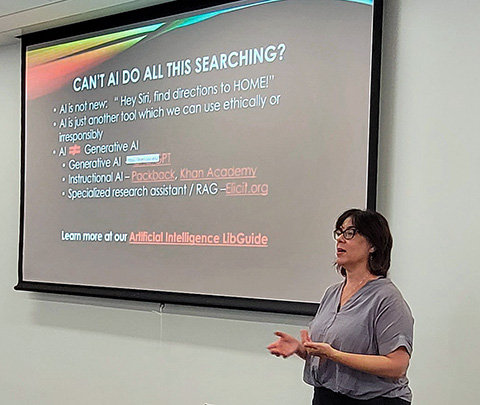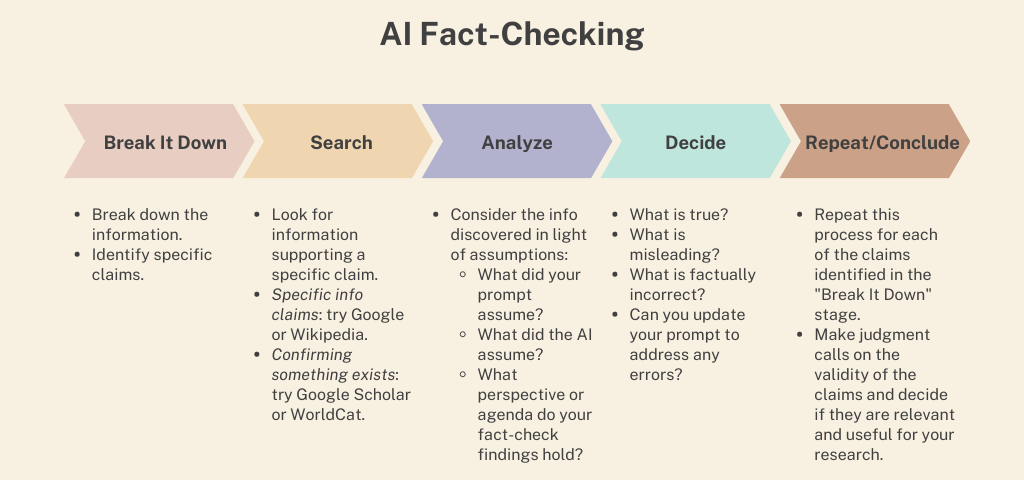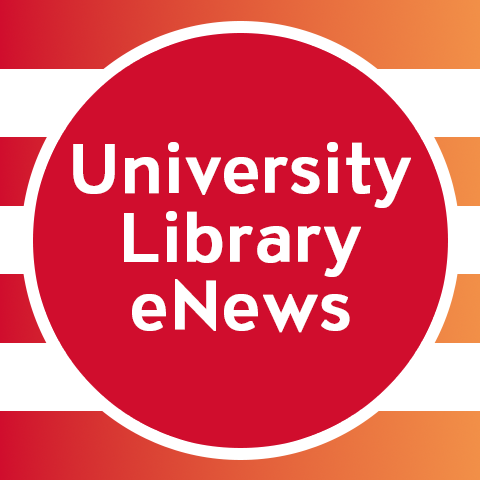Newsletter Edition: Fall 2025
Contributed by Elizabeth Altman
Tools integrating artificial intelligence (AI) capabilities have been widely available for over a decade. Siri appeared in iOS products starting in 2008, and music streaming apps started predicting our preferences around the same time. OpenAI made its Generative AI ChatGPT service available in late 2022, and we are by now familiar with the “AI Overview” Google provides in response to most searches. AI’s ability to process, generate, and present information at a superhuman pace has prompted a group of CSUN librarians to explore its implications for research and instruction, and help students and faculty to engage its rapidly growing presence in education.

The University Library Artificial Intelligence Working Group (AIWG) was initiated in the late Spring, 2024 by Stephen Kutay (Digital Services Librarian), Lisa Cheby (Dr. Karin J. Duran and Richard Nupoll Education Librarian), and Brianna Limas (Outreach Librarian). Cheby and Limas had presented on “The New Wild West of Artificial Intelligence (A.I.)” at a CSUN faculty retreat, and Kutay, already using AI for audio transcription, wanted to identify tools that could make digital collections fully accessible. “We wanted to give CSUN librarians some agency over the technologies and policies quickly entering into our educational environment,” said Kutay. “In addition to the many tools arriving on the market, it was clear that AI was significantly changing information retrieval, and we felt we needed a group to hash through the good and bad of these unregulated and powerful technologies.”
The group’s proposal was approved by then-Library Dean Mark Stover, and now the group, consisting of roughly 12 members, meets monthly. Its mission includes a commitment to working “with stakeholders, including, but not limited to campus faculty, students, and administrators to provide guidance and assistance on using AI as an information technology and to assist the campus community in the ethical and effective use of AI in education and research.”
“At the time, everyone was working separately to get up to speed on this new technology as it became more mainstream,” said Limas. “Steve was already developing an AI library guide, and two other librarians were drafting a guide focused on ChatGPT. But the learning curve for these products is steep, so we’d talk at department meetings about combining our efforts to learn how to use these tools, how not to use them, and what their implications are for learning, the information landscape, and the environment.”
“Brianna really brought my attention to the sustainability issues accompanying the use of AI,” remarked Cheby, who chairs the working group. “I had been doing presentations to the California Association of School Librarians about the role of AI literacy in inquiry learning. Inquiry learning strategies teach students to generate questions and analyze information in response to those questions, so information literacy skills – including AI information literacy skills – are critical.”
Information literacy instruction and support for information navigation is core to the mission of all libraries, but it has become particularly important because of the California State University (CSU) AI Initiative. In early February 2025, the CSU Office of the Chancellor announced a “first-of-its-kind public-private initiative … that will leverage the power of artificial intelligence to create an AI-empowered higher education system that could surpass any existing model in both scale and impact.” The initiative includes partnerships with technology companies such as Adobe, Alphabet (Google), LinkedIn, Microsoft, and OpenAI, to provide all CSU students, faculty and staff access to AI-based tools, identify AI-associated skills needed to prepare graduates for future careers, and support faculty exploration of the use of AI in instruction and research. Perhaps most significant was a contract with OpenAI to provide ChatGPT Edu, a campus-tailored edition of its GPT-5 platform, to a limited number of users for the first half of 2025, then to all CSU students, faculty and staff for the 2025-2026 fiscal year.
Cheby notes that librarian guidance through the AI environment is critical because there are so many different types of AI. “When you approach a librarian with an information need, we should consider AI resources the same way we would consider any resource, database, dataset, journal. What's the best place to go for that information? I think part of our job as information professionals is understanding how these systems work and what makes them an appropriate – or inappropriate – resource for the need.”
While some CSUN faculty have joined the CSUN AI Task Force to actively explore uses for AI in instruction and research, others have been overwhelmed by the AI Initiative and have implemented course policies to minimize their students’ use of AI. The Faculty Senate, in fact, passed a resolution critiquing the adoption of ChatGPT Edu at CSUN and across the CSU system. Against a backdrop of this mixed response, Limas sees AI-literate librarians as potentially bridging the gap between apprehensiveness and understanding so that faculty who wish to can enhance their instruction with AI tools without feeling intimidated. “By openly asking critical questions about AI as a resource, we hope to prevent faculty from perceiving AI is a detriment to their instruction, and show that appropriate use of AI by students can be evaluated just as any other research task can.”

Cheby noted, “We initially focused on concrete deliverables, such as our Artificial Intelligence LibGuide, and a Canvas module in our Online Research Toolkit on Generative AI and Research.” AIWG is also planning in-person and virtual events, including training sessions for faculty and “community conversations” with students and faculty where people will be encouraged to talk about AI.
AIWG is partnering with similar groups across campus. Meetings are attended by Megan Duncan, a Academic Technology staffer, to maintain a flow of information with the Library. Several AIWG members will be making presentations in a faculty presentation series organized by Dr. Anne Choi, Associate VP of Faculty Initiatives and Programs, on topics such as AI literacy, , and AI functions being incorporated into library databases.
“At the moment we don’t know a lot about how professors are using AI in their qualitative and quantitative research,” said Cheby, “or how much AI functionality has been incorporated into the platforms they were already using. Everybody needs to get a better sense of the specific use cases for AI, and the teaching faculty can’t answer that for the students if nobody’s answering it for them. I’ve tried asking library faculty and staff, how are you incorporating AI tools into your everyday work? But people have been slow to respond. People are sometimes uncomfortable discussing AI, and we are hoping to encourage more conversation with an information session for the library.”
The availability of ChatGPT, meanwhile, has provided Steve Kutay with a useful tool to write code for managing the thousands of digital files he processes and curates in his capacity as Digital Services Librarian. “I can copy and move large quantities of files in a specific format, so I don't have to browse directories or manually open folders. I got through 15 TB of image data in 8 external drives in about 12 hours. You have to be very thoughtful and specific about the prompt, but since I can safely test the output without affecting any files, I don’t have to think specifically about the code.”
You can learn more about the AI Initiative by visiting:
Sources
Barajas, J. (2025, August 19). Inside Cal State's big $17 million bet on ChatGPT for all. https://laist.com/news/education/chatgpt-california-state-university-csu-ai-deal
Media Relations and Public Affairs, California State University. (2025, March 4). CSU Announces Landmark Initiative to Become Nation’s First and Largest AI-Empowered University System https://www.calstate.edu/csu-system/news/Pages/CSU-AI-Powered-Initiative.aspx
